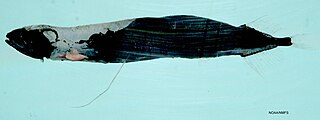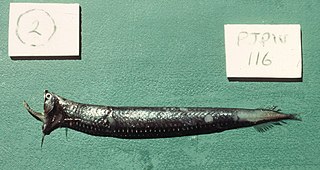 W
WStomiidae is a family of deep-sea ray-finned fish, including the barbeled dragonfishes. They are quite small, usually around 15 cm, up to 26 cm. These fish are apex predators and have enormous jaws filled with fang-like teeth. They are also able to hinge the neurocranium and upper-jaw system, which leads to the opening of the jaw to more than 100 degrees. This ability allows them to consume extremely large prey, often 50% greater than their standard length.
 W
WSnaggletooths or stareaters are any of a number of small, deep-sea stomiid fish in the genus Astronesthes. They possess a bioluminescent red chin barbel that the fish use as a lure to attract small prey into striking distance.
 W
WAstronesthes niger, commonly known as snaggletooth, is a species of small, deep sea fish in the family Stomiidae. It occurs in the tropical and subtropical Atlantic Ocean, the Caribbean Sea and the Gulf of Mexico, as well as the Indian Ocean and western Pacific Ocean, at depths to 1,000 m (3,300 ft).
 W
WBathophilus is a genus of barbeled dragonfishes native to the ocean depths of the Pacific, Atlantic and Indian oceans.
 W
WA viperfish is any species of marine fish in the genus Chauliodus. Viperfish are characterized by long, needle-like teeth and hinged lower jaws. A typical viperfish grows to lengths of 30 to 60 cm. Viperfish stay near lower depths in the daytime and shallower depths at night, primarily in tropical and temperate waters. Viperfish are believed to attack prey after luring them within range with light-producing organs called photophores, which are located along the ventral sides of its body, and with a prominent photophore at the end of a long spine in the dorsal fin reminiscent of the illicium of the unrelated deepsea anglerfishes. The viperfish flashes this natural light on and off, at the same time moving its dorsal spine around like a fishing rod and hanging completely still in the water. It also uses the light producing organ to communicate to potential mates and rivals.
 W
WIdiacanthus is a genus of barbeled dragonfishes, the larvae of which are noted for exhibiting the Stylophthalmine trait.
 W
WIdiacanthus atlanticus is a barbeled dragonfish of the family Stomiidae, found circumglobally in southern subtropical and temperate oceans between latitudes 25°S and 60°E, at depths down to 2,000 metres (6,600 ft). The species is sexually dimorphic: females are black with six stripes; males are brown, and lack the females' canine teeth, pelvic fins and barbel. Females are believed to make a diel vertical migration from deeper than 500 metres (1,600 ft) by day to surface waters at night, whereas males do not migrate, remaining below 1,000 metres (3,300 ft) at all times.
 W
WThe stoplight loosejaws are small, deep-sea dragonfishes of the genus Malacosteus, classified either within the subfamily Malacosteinae of the family Stomiidae, or in the separate family Malacosteidae. They are found worldwide, outside of the Arctic and Subantarctic, in the mesopelagic zone below a depth of 500 meters. This genus once contained three nominal species: M. niger, M. choristodactylus, and M. danae, with the validity of the latter two species being challenged by different authors at various times. In 2007, Kenaley examined over 450 stoplight loosejaw specimens and revised the genus to contain two species, M. niger and the new M. australis.
 W
WMalacosteus niger is a species of fish in the family Stomiidae, the barbeled dragonfishes. It is known by the common names northern stoplight loosejaw, lightless loosejaw, black loosejaw, and black hinged-head. It lives in oceans around the world from tropical to subarctic waters.
 W
WPhotostomias is a genus of barbeled dragonfishes.
 W
WSnaggletooths or stareaters are any of a number of small, deep-sea stomiid fish in the genus Astronesthes. They possess a bioluminescent red chin barbel that the fish use as a lure to attract small prey into striking distance.
 W
WStomias is a genus of barbeled dragonfishes. They live in the mesopelagic zone of all oceans and show diel vertical migration and sexual dimorphism (males are smaller, have larger eyes and larger postorbital photophores than females.
 W
WThe stoplight loosejaws are small, deep-sea dragonfishes of the genus Malacosteus, classified either within the subfamily Malacosteinae of the family Stomiidae, or in the separate family Malacosteidae. They are found worldwide, outside of the Arctic and Subantarctic, in the mesopelagic zone below a depth of 500 meters. This genus once contained three nominal species: M. niger, M. choristodactylus, and M. danae, with the validity of the latter two species being challenged by different authors at various times. In 2007, Kenaley examined over 450 stoplight loosejaw specimens and revised the genus to contain two species, M. niger and the new M. australis.